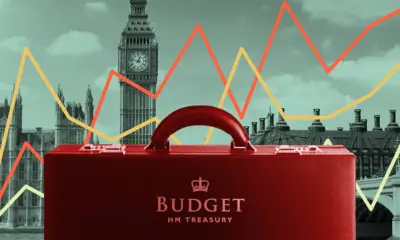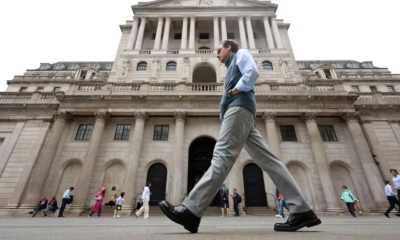Business
Monetary Policy Tightening Isn’t Over: Why Some BoE Officials Warn Rates Must Stay Elevated

Introduction
As 2025 progresses, the debate within the Bank of England over the future path of interest rates remains intense. While inflation has eased from its highs, several senior officials have cautioned against assuming the tightening cycle is complete. Their message is clear: monetary policy must remain restrictive for longer to ensure that price stability is firmly restored. This cautious stance reflects lingering inflationary pressures, persistent wage growth, and uncertainty in global markets. For households and businesses hoping for quick relief from higher borrowing costs, the central bank’s message may come as an unwelcome reality check.
The Current Policy Landscape
The Bank of England’s base rate currently sits at 4.25 percent after a modest reduction earlier this year. While this marks a shift from the aggressive hikes of 2023 and 2024, policymakers are far from declaring victory over inflation. The headline consumer price index has fallen to around 3 percent, but core inflation remains elevated at roughly 3.4 percent, driven by strong service-sector pricing and wage dynamics.
Officials such as Chief Economist Huw Pill and Deputy Governor Ben Broadbent have warned that the journey back to the two percent target is not guaranteed. They argue that policy must continue to lean against residual inflationary pressures until there is clear and sustained evidence of disinflation. This sentiment has shaped recent communications from the Monetary Policy Committee, which emphasize patience and vigilance over premature easing.
Persistent Inflation Pressures
While the pace of inflation has slowed, several structural factors are keeping price growth above the target range. The first is continued wage strength. Average earnings are rising at an annual rate of just above 5 percent, outpacing productivity growth and fueling service-sector inflation. Employers in hospitality, logistics, and healthcare continue to raise pay to attract workers, creating a feedback loop that sustains price pressures.
Another challenge comes from energy and food prices. Although global energy costs have stabilized compared with the spikes of 2022, geopolitical tensions and supply disruptions still pose risks. Uncertainty surrounding commodity markets could easily translate into renewed inflationary volatility, particularly if global demand strengthens again.
Housing costs also play a role. Higher mortgage rates have cooled property prices but have pushed up rents as demand for rental accommodation surges. This dynamic feeds into broader inflation measures, particularly in urban areas where affordability pressures remain acute.
Why Some Officials Advocate Caution
The argument for keeping rates elevated rests on the belief that inflation expectations remain fragile. If consumers and businesses begin to assume that prices will rise faster than the official target, it becomes harder to control inflation without more aggressive intervention later. By maintaining a restrictive stance, the Bank of England hopes to anchor expectations and reinforce credibility.
Officials also point to the global policy environment. The US Federal Reserve and the European Central Bank are pursuing similarly cautious approaches, maintaining higher rates even as inflation moderates. This alignment helps prevent capital outflows and supports currency stability, both of which are vital for the UK’s financial health. A premature divergence could weaken the pound, raise import prices, and reignite inflation.
Moreover, some policymakers view the current period as an opportunity to rebuild resilience. After years of ultra-loose monetary conditions, higher rates encourage more disciplined lending and reduce the risk of financial imbalances. They argue that the economy must adapt to a new normal where borrowing costs better reflect underlying risks.
The Case for Patience
Advocates of patience believe that time, not additional tightening, will complete the job. They point out that monetary policy operates with long and uncertain lags. The full impact of previous rate increases is still filtering through the economy, particularly in housing and business investment. Many households have yet to refinance mortgages at higher rates, meaning the pressure on spending will intensify over the next year.
Keeping rates high for an extended period may therefore be more effective than further increases. It allows inflation to fall naturally as demand cools, while avoiding the shock that another round of hikes might deliver to already strained borrowers. This gradualist approach aligns with the Bank’s desire to maintain stability and credibility without triggering unnecessary volatility.
Economic Trade-Offs and Political Pressures
The central bank’s stance is not without controversy. Critics argue that maintaining restrictive policy risks stifling economic growth and worsening inequality. Business groups have warned that elevated rates could dampen investment and hiring, while consumer organizations highlight the burden on households with variable-rate mortgages.
The government faces pressure to demonstrate progress on economic growth ahead of the next general election, but the Bank of England remains steadfast in its independence. Governor Andrew Bailey and his colleagues insist that policy decisions must prioritize inflation control above short-term political considerations. Their cautious tone reflects a belief that stable prices are a prerequisite for sustainable growth.
Market Reactions and Financial Conditions
Financial markets have adjusted to the expectation that rates will remain higher for longer. Yields on government bonds have stabilized near 3.8 percent, and swap markets now price only a gradual decline in the base rate through 2026. The pound has strengthened modestly against major currencies, supported by the perception that UK monetary policy will remain tighter than that of several peers.
Mortgage rates, meanwhile, have shown only slight declines. Average two-year fixed deals remain around 4.5 percent, while five-year rates hover near 4.2 percent. For borrowers, this means that affordability pressures are likely to persist even as inflation continues to fall. However, the steadiness in financial markets suggests that the Bank’s communication strategy is working. By clearly signaling its intentions, it has helped avoid the volatility that often accompanies uncertainty about rate direction.
Looking Ahead
The next several months will be crucial for determining whether the Bank of England’s caution proves justified. Policymakers will monitor wage settlements, inflation expectations, and global energy trends closely. If data confirm that underlying price pressures are easing sustainably, gradual rate cuts could begin in the second half of 2026. But if inflation proves stubborn, officials have signaled that they are prepared to keep policy tight for as long as necessary.
Businesses and households should prepare for a period of stability rather than rapid change. The era of near-zero interest rates is unlikely to return soon. Instead, the economy is moving toward a more balanced environment where borrowing costs are aligned with long-term growth and inflation dynamics.
Conclusion
The message from the Bank of England is one of cautious persistence. While inflation has retreated from its peaks, it has not yet been fully defeated. Some officials believe that keeping rates elevated is the safest path to restoring confidence and preventing a resurgence of price pressures. For consumers and investors, this means adjusting expectations to a world where higher interest rates are the norm rather than the exception. The Bank’s steady hand may slow growth in the short term, but it aims to secure the lasting stability needed for the UK economy to thrive in the years ahead.




















